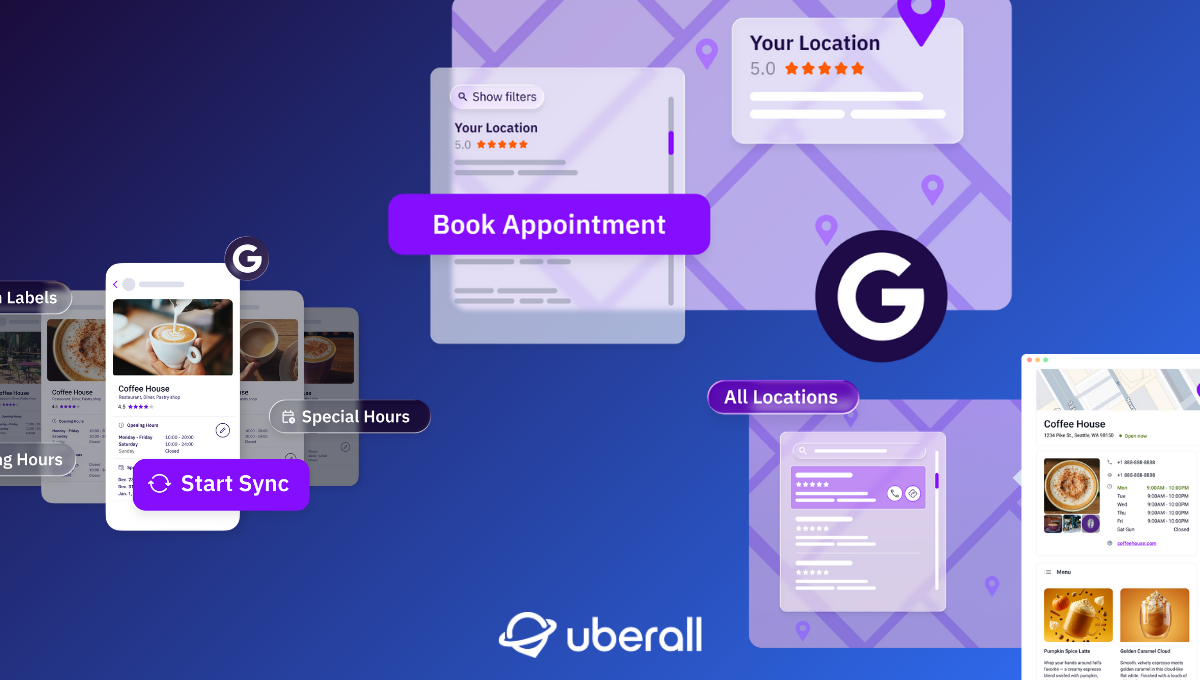
10 Tips How to Create a Store Locator That Converts
A store locator is the most powerful tool in your website's location-based marketing arsenal. Let us show you how to build the perfect one!
Ever find yourself searching online for a store nearby, only to end up frustrated by the lack of clear directions? That's where a great store locator comes in—though it isn’t just a nice-to-have feature, but a powerful tool to turn online interest into in-store visits.
However, creating an effective store locator requires careful consideration of design, user experience, and technical optimization. In this guide, we’ll explore ten essential tips to build the perfect store locator that not only drives traffic but also converts it into tangible results.
Why a Store Locator is Crucial for Your Business
A store locator is the most powerful tool in your website's location-based marketing arsenal. Why? Because 98% of consumers search online for local businesses before making a purchase.
A store locator bridges the gap between online browsing and physical shopping, guiding customers directly to your nearest location. But beyond simply providing an address, a store locator will do much more.
Stronger Local Digital Marketing
A store locator shines a spotlight on your local stores, making them just a few clicks away from a visit. So this tool amplifies your location-based marketing efforts, ensuring that your stores are visible to potential customers when they need them the most. Also, 93% of consumers check the address of a location before visiting it for the first time.
Higher Local Search Rankings
By integrating a store locator into your website, you’ll be sendingstrong signals to search engines like Google. This boosts your visibility in organic and local search results, attracting more foot traffic to your stores.
Seamless Customer Journey
When customers are searching for a store, they are most often ready to make a purchase: our customer data suggests an average 10% click-through-rate on locator and local pages—because they simplify the conversion process, guiding them smoothly to their destination.
Now, let’s dive into the ten tips that will help you create the perfect store locator.
How to Build the Perfect Store Locator
Crafting an effective store locator requires more than just basic functionality. To maximize its impact, you need to focus on the details that make it intuitive, user-friendly, and optimized for search engines.
1. Place the Store Locator Prominently on Your Website
The effectiveness of a store locator starts with its accessibility. It should be easy to find on your website, ideally linked directly from the top-level menu. This placement ensures it is fully integrated into your website and easy for users to access without unnecessary clicks.
While some businesses opt to host their store locators on a separate domain, it’s usually more efficient to keep everything in one place. Maintaining a single, integrated site reduces the risk of errors and ensures consistent updates, ultimately safeguarding your position in local search results.
Best Practice Example
LAKRIDS BY BÜLOW, a Danish licorice manufacturer and retailer, integrated their store locator directly into their main website, ensuring a seamless experience for customers. This approach not only simplified the user journey but also improved the brand's local search visibility, leading to increased in-store visits.
2. Optimize for User Experience
A successful store locator hinges on user experience (UX), with the goal to make it as intuitive and user-friendly as possible. Our advice: start with basic search functionality, allowing users to search for stores by city or postal code.
To further enhance usability, consider adding filters like "open now" or "parking available," which cater to specific customer needs. And if there are no stores in a particular area, suggest the nearest alternative.
Make sure the map pins are accurately placed—down to the exact street and building. For businesses with numerous locations, clustering nearby stores on the map can prevent overcrowding. Also, branded pins allow you to distinguish between offerings, such as a branch with actual people vs ‘just’ an ATM.
Beyond just functionality, using your brand’s colors, fonts, and styles in the store locator will strengthen brand recognition and ensure a cohesive look across all platforms. And if your business spans multiple countries, ensure that language options are available to accommodate your international customers.
Best Practice Example
Henkel’s Schwarzkopf Professional, a global beauty brand, optimized its store locator with easy-to-use search filters for services (like “hair extensions”) and brands (like “BLONDME”). This not only enhanced the customer experience but also improved satisfaction, as users could easily find the most relevant store for their needs.
3. Use a Responsive Design
With the majority of consumers now searching for products and services on their smartphones, your store locator must be mobile-friendly. A responsive design ensures that your store locator adapts to different screen sizes, providing a consistent experience.
4. Keep Loading Times Under 3 Seconds
Website speed is critical for all parts of your search engine optimization as more than half of users will abandon your site if it takes longer than six seconds to load—and on mobile devices, that patience drops to just three seconds. So ensuring your store locator loads quickly can mean the difference between a lost visitor and a new customer.
Tools like Google PageSpeed Insights or YSlow can help you monitor and optimize your site’s load times. And remember, a fast-loading store locator contributes to overall website performance, keeping potential customers engaged and driving more visits to your physical stores.
5. Provide Clear Call-to-Actions (CTAs)
A store locator’s primary purpose is to drive action: whether that’s visiting a store, calling, or getting directions. Clear, direct CTAs make it easy for users to take the next step.
Instead of just listing a phone number, include a "Call Now" button; and instead of just providing an address, include a "Get Directions" button that integrates with mapping apps. These small touches can greatly improve the user experience and increase the likelihood of conversion.
However, make sure that your CTA aligns with your main business goal: whether it’s booking a table, making an appointment, subscribing to a newsletter or purchasing a product.
6. Create and Link Local Landing Pages
Local landing pages are a powerful extension of your store locator, offering detailed information about each location, such as hours of operation, available services, customer reviews, and photos. These pages not only enhance the customer journey by providing all necessary details in one place but also improve your local SEO efforts.
By optimizing these pages with location-specific keywords, you increase the chances of appearing in the coveted Google Local Pack, which displays the top local results in a given area.
Best Practice Example
BIO COMPANY, an organic supermarket chain, uses local landing pages to provide customers with comprehensive information about their locations, including services offered and customer reviews. This approach boosts their visibility in local search results and drives more traffic to their stores.
7. Ensure Your Store Locator is Indexed by Search Engines
Before customers can find your store locator, search engines must be able to index it. This involves ensuring that your locator and associated pages are crawlable and contain consistent data.
Using structured data, such as schema markup, can further enhance your store locator's visibility by helping search engines understand the content and context of your pages. Also, regularly updating your locator with accurate information improves the likelihood of being prominently displayed in search results.
8. Use SEO-Friendly URLs for Your Locator and Local Pages
URLs play a crucial role in SEO. Instead of relying on automatically generated URLs from your content management system (CMS), customize them to be descriptive and keyword-rich. For instance, a URL like yourwebsite.com/store-locator is much more effective than yourwebsite.com/page-id-12345.
For local landing pages, include the city or neighborhood in the URL to help search engines and users understand what to expect from the page; for example yourwebsite.com/store-locator/seattle.
Speaking of naming conventions: opt for clear and descriptive names such as "Store Finder" "Restaurant Locator" or "Branch Finder", while avoiding vague titles like "Find a Burger".
9. Integrate the Store Locator into Your Performance Analytics
Understanding how customers use your store locator is essential for refining the user experience and optimizing performance. Integrating your locator with analytics tools allows you to track user interactions, such as searches performed, filters used, and locations viewed.
These insights can reveal valuable information, such as which locations are most popular or if there is demand for a new store in a specific area. This data-driven marketing approach ensures that your store locator continues to meet customer needs and drives business growth.
10. Manage All Information from a Centralized Platform
Maintaining accurate and up-to-date information across all platforms is critical. By managing your store locator from a centralized platform, you can ensure consistency in data across your website, social media, and other digital touchpoints.
Centralized management also allows for real-time updates, so any changes to store hours, locations, or services can be immediately reflected across all channels. This not only saves time but also reduces the risk of errors, ensuring that customers always receive accurate information.
Best Practice Example
Orlen, a leading fuel retailer, successfully centralized its location data management on a single platform—including listings, locator and local pages management. This approach ensures that customers always receive accurate and consistent information, driving higher engagement and in-store visits.
Conclusion
A well-designed store locator is more than just a map with pins—it’s a vital tool that connects online and offline experiences. By following our ten tips, you can create a store locator that not only meets but exceeds customer expectations, turning online interest into real-world results.
From placing the store locator prominently on your website to ensuring it’s mobile-friendly and integrated with local SEO strategies, each step contributes to a seamless customer journey. Whether you’re managing a few locations or hundreds, a carefully optimized store locator can be a game-changer for your business.
Perfect Precision: This is Uberall Store Locator
In addition to following best practices, the efficiency and accuracy of your store locator depend on how well you manage your location data—and with Uberall, you can take your store locator (and local pages) to the next level!
A tool like Uberall's Locator & Local Pages offers centralized control over features such as real-time updates, automatic synchronization across platforms, and customizable local landing pages. This ensures that critical information—like store hours, contact det
Ready to Transform Your Business?
Connect with our partnership team to learn how Uberall can help you achieve similar results. Get a personalized consultation and discover the opportunities waiting for your business.
Resources











